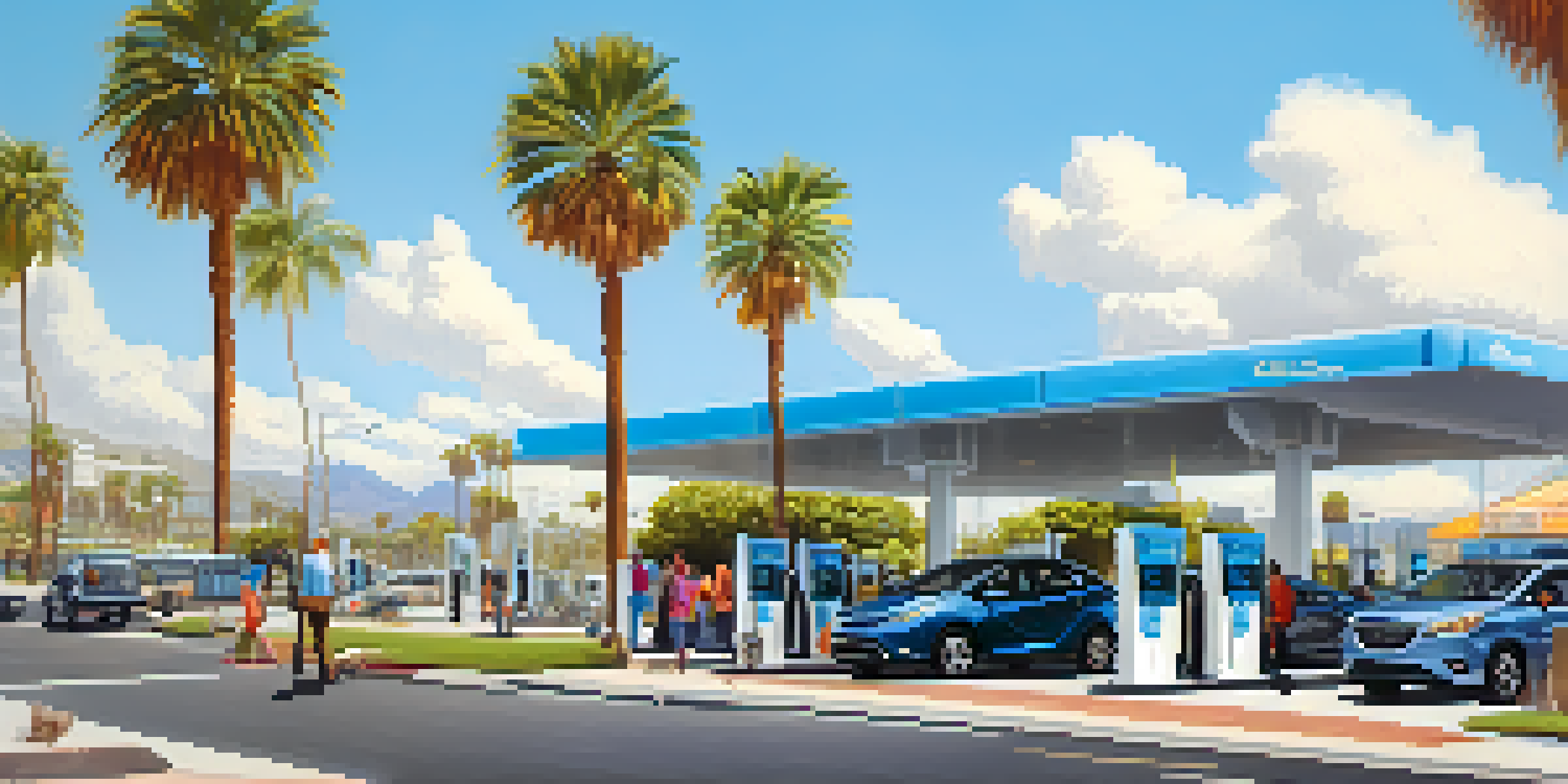California's Role in Advancing Hydrogen Fuel Cell Technology

Overview of Hydrogen Fuel Cell Technology
Hydrogen fuel cells are devices that convert hydrogen and oxygen into electricity, with water as the only byproduct. This clean energy technology has gained traction as a sustainable alternative to fossil fuels, especially in transportation and stationary power generation. By harnessing hydrogen's potential, we can significantly reduce greenhouse gas emissions and promote energy independence.
Hydrogen is the fuel of the future, and California is leading the way in making it a reality.
In essence, hydrogen fuel cells work like batteries but can be refueled quickly and provide longer ranges. They have applications in various sectors, including automotive, aerospace, and industrial processes. As we look toward a greener future, understanding how hydrogen fuel cells operate is crucial for embracing this transformative technology.
California, with its diverse geography and economy, is at the forefront of this energy revolution. The state's commitment to clean energy and innovation makes it a prime location for developing and implementing hydrogen fuel cell technology.
California's Commitment to Clean Energy
California has long been a leader in environmental policies aimed at reducing carbon emissions. The state's aggressive targets for renewable energy usage and greenhouse gas reductions have paved the way for innovative technologies like hydrogen fuel cells. This commitment is evident in statewide initiatives that promote clean energy sources and sustainable practices.

The California Air Resources Board (CARB) has established several programs to support hydrogen fuel cell adoption, including financial incentives and funding for research. These initiatives encourage both consumers and businesses to invest in hydrogen technology, fostering a culture of innovation and sustainability.
California Leads Hydrogen Innovation
The state's commitment to clean energy and strong policies is driving advancements in hydrogen fuel cell technology.
By setting ambitious goals, California not only aims to combat climate change but also to create jobs and stimulate economic growth. The state's proactive stance on clean energy serves as a model for other regions looking to embrace similar technologies.
Key Players in California's Hydrogen Sector
Several key organizations and companies are driving advancements in hydrogen fuel cell technology within California. Notable players include Toyota, Honda, and several startups dedicated to hydrogen production and distribution. These companies are investing heavily in research and development to improve fuel cell efficiency and affordability.
The transition to hydrogen fuel cells will not only help combat climate change but also drive innovation and economic growth.
In addition to automakers, California is home to research institutions and universities that are pioneering hydrogen technology. Collaborations between academia and industry help to accelerate innovation and bring new ideas to market. This synergy fosters a vibrant ecosystem that supports the growth of hydrogen fuel cells.
Public-private partnerships are also crucial in creating a robust hydrogen infrastructure. By working together, these entities can address challenges related to production, storage, and distribution, ensuring that hydrogen fuel cells can be widely adopted.
Innovative Projects and Initiatives
California has launched several innovative projects to showcase the potential of hydrogen fuel cells. One such initiative is the California Hydrogen Highway Network, which aims to create a comprehensive network of hydrogen fueling stations across the state. This project is critical for enabling hydrogen-powered vehicles to travel long distances without range anxiety.
Additionally, various pilot programs are testing hydrogen technology in public transportation. Cities like Los Angeles and San Francisco are exploring hydrogen buses and other vehicles, demonstrating the viability of this clean energy solution in urban settings. These projects not only reduce emissions but also provide valuable data for future developments.
Challenges Hinder Widespread Adoption
High production costs and lack of infrastructure are significant hurdles that must be overcome for hydrogen fuel cells to gain traction.
By investing in such initiatives, California is positioning itself as a global leader in hydrogen technology. Each successful project contributes to the broader goal of creating a sustainable energy future and showcases the possibilities hydrogen fuel cells offer.
Challenges Facing Hydrogen Fuel Cell Adoption
Despite its potential, hydrogen fuel cell technology faces several challenges that must be addressed for widespread adoption. One of the primary hurdles is the cost of production, as producing hydrogen sustainably can be expensive. As technology advances, however, these costs are expected to decrease, making hydrogen a more attractive option.
Another challenge is the current lack of infrastructure for hydrogen fueling stations. While California is making strides with projects like the Hydrogen Highway, more investment is needed to establish a comprehensive network. Without sufficient fueling options, consumers may hesitate to transition to hydrogen-powered vehicles.
Lastly, public perception and understanding of hydrogen technology play a significant role in its adoption. Educating consumers about the benefits and safety of hydrogen fuel cells is essential for fostering acceptance and encouraging a shift towards this clean energy source.
The Future of Hydrogen Fuel Cells in California
The future of hydrogen fuel cells in California looks promising, with ongoing advancements and increased investment. As technology continues to evolve, we can expect improvements in efficiency and reductions in costs, making hydrogen an even more viable energy source. The state's commitment to innovation and sustainability will undoubtedly drive further developments.
Moreover, California's aggressive climate goals set the stage for hydrogen technology to flourish. As the state aims for carbon neutrality by 2045, hydrogen fuel cells will play a crucial role in achieving these objectives. The integration of hydrogen into various sectors, including transportation and energy storage, will be essential for a sustainable future.
Future Looks Bright for Hydrogen Energy
Ongoing investment and technological advancements indicate a promising future for hydrogen fuel cells in California's sustainable energy landscape.
Ultimately, California's leadership in hydrogen fuel cell technology serves as an inspiration for other regions. By embracing and investing in this clean energy solution, we can collectively pave the way for a greener, more sustainable world.
Conclusion: California as a Hydrogen Fuel Cell Leader
California's role in advancing hydrogen fuel cell technology is pivotal, showcasing how innovation can drive sustainability. With a combination of strong policies, industry support, and public initiatives, the state is making significant strides towards a cleaner energy future. This leadership is not just about technology; it’s about creating a healthier planet for future generations.
As we reflect on the progress made, it becomes clear that the journey is just beginning. The challenges that lie ahead are substantial, but California's commitment to overcoming them is unwavering. By continuing to invest in hydrogen technology, the state is setting a precedent that others can follow.

In conclusion, California's pioneering efforts in hydrogen fuel cells highlight the potential of clean energy solutions. With ongoing collaboration and innovation, the state is poised to lead the way in transforming our energy landscape and achieving a sustainable future.